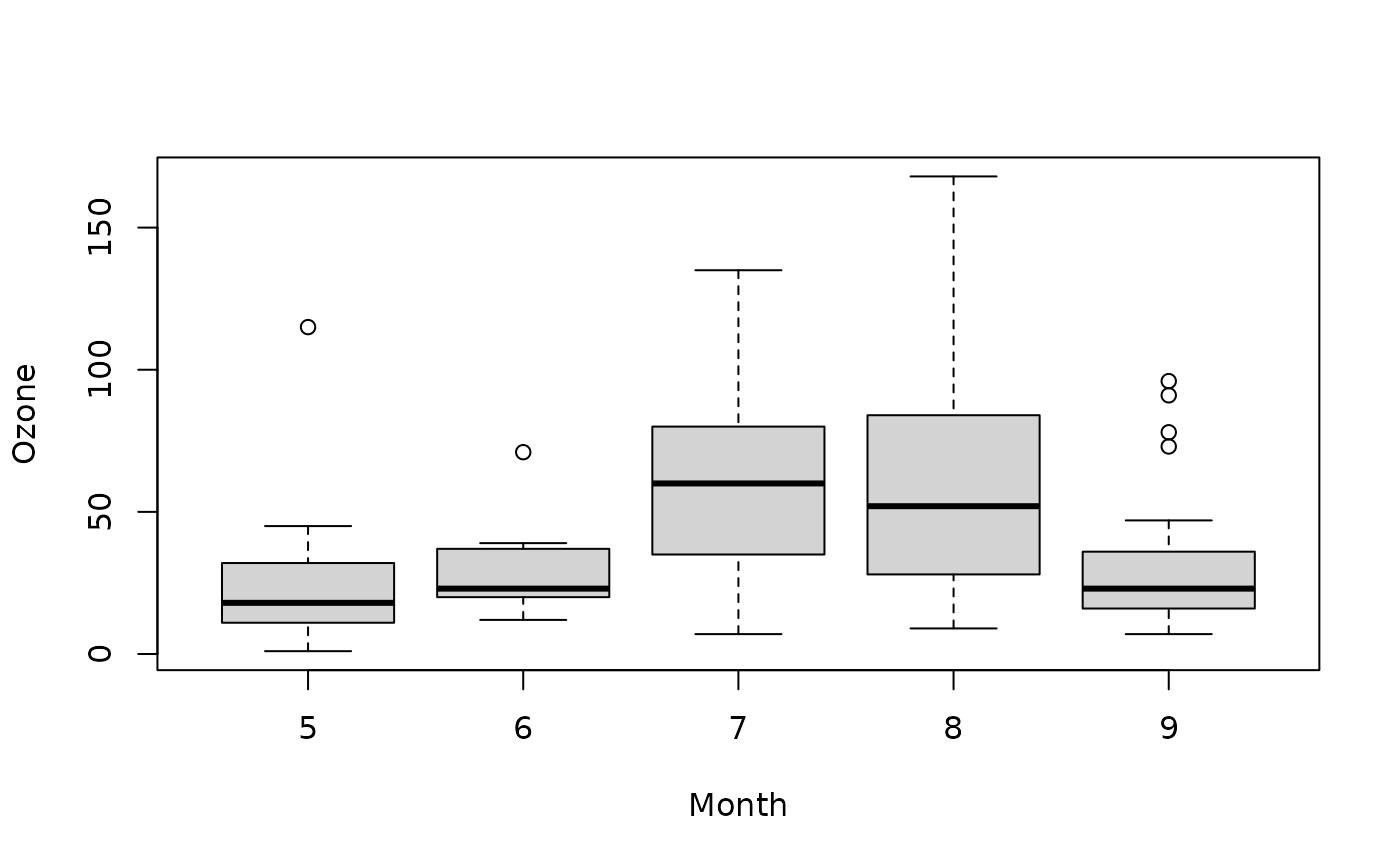Dunn's Test of Multiple Comparisons
DunnTest.RdPerforms Dunn's test of multiple comparisons using rank sums.
DunnTest(x, ...)
# Default S3 method
DunnTest(x, g,
method = c("holm", "hochberg", "hommel", "bonferroni", "BH",
"BY", "fdr", "none"),
alternative = c("two.sided", "less", "greater"),
out.list = TRUE, ...)
# S3 method for class 'formula'
DunnTest(formula, data, subset, na.action, ...)
# S3 method for class 'DunnTest'
print(x, digits = getOption("digits", 3), ...)Arguments
- x
a numeric vector of data values, or a list of numeric data vectors.
- g
a vector or factor object giving the group for the corresponding elements of
x. Ignored ifxis a list.- method
the method for adjusting p-values for multiple comparisons. The function is calling
p.adjustand this parameter is directly passed through.- alternative
a character string specifying the alternative hypothesis, must be one of
"two.sided"(default),"greater"or"less". You can specify just the initial letter.- out.list
logical, indicating if the results should be printed in list mode or as a square matrix. Default is list (TRUE).
- formula
a formula of the form
lhs ~ rhswherelhsgives the data values andrhsthe corresponding groups.- data
an optional matrix or data frame (or similar: see
model.frame) containing the variables in the formulaformula. By default the variables are taken fromenvironment(formula).- subset
an optional vector specifying a subset of observations to be used.
- na.action
a function which indicates what should happen when the data contain
NAs. Defaults togetOption("na.action").- digits
controls the number of fixed digits to print.
- ...
further arguments to be passed to or from methods.
Details
DunnTest performs the post hoc pairwise multiple comparisons procedure appropriate to follow the rejection of a Kruskal-Wallis test. The Kruskal-Wallis test, being a non-parametric analog of the one-way ANOVA, is an omnibus test of the null hypothesis that none of k groups stochastically dominate one another.
Dunn's test is constructed in part by summing jointly ranked data. The rank sum test, itself a non-parametric analog of the unpaired t-test, is possibly intuitive, but inappropriate as a post hoc pairwise test, because (1) it fails to retain the dependent ranking that produced the Kruskal-Wallis test statistic, and (2) it does not incorporate the pooled variance estimate implied by the null hypothesis of the Kruskal-Wallis test.
If x is a list, its elements are taken as the samples to be
compared, and hence have to be numeric data vectors. In this case,
g is ignored, and one can simply use DunnTest(x)
to perform the test. If the samples are not yet contained in a
list, use DunnTest(list(x, ...)).
Otherwise, x must be a numeric data vector, and g must
be a vector or factor object of the same length as x giving
the group for the corresponding elements of x.
Value
A list with class "DunnTest" containing the following components:
- res
an array containing the mean rank differencens and the according p-values
References
Dunn, O. J. (1961) Multiple comparisons among means Journal of the American Statistical Association, 56(293):52-64.
Dunn, O. J. (1964) Multiple comparisons using rank sums Technometrics, 6(3):241-252.
See also
Examples
## Hollander & Wolfe (1973), 116.
## Mucociliary efficiency from the rate of removal of dust in normal
## subjects, subjects with obstructive airway disease, and subjects
## with asbestosis.
x <- c(2.9, 3.0, 2.5, 2.6, 3.2) # normal subjects
y <- c(3.8, 2.7, 4.0, 2.4) # with obstructive airway disease
z <- c(2.8, 3.4, 3.7, 2.2, 2.0) # with asbestosis
DunnTest(list(x, y, z))
#>
#> Dunn's test of multiple comparisons using rank sums : holm
#>
#> mean.rank.diff pval
#> 2-1 1.8 1.0000
#> 3-1 -0.6 1.0000
#> 3-2 -2.4 1.0000
#> ---
#> Signif. codes: 0 '***' 0.001 '**' 0.01 '*' 0.05 '.' 0.1 ' ' 1
#>
## Equivalently,
x <- c(x, y, z)
g <- factor(rep(1:3, c(5, 4, 5)),
labels = c("Normal subjects",
"Subjects with obstructive airway disease",
"Subjects with asbestosis"))
# do the kruskal.test first
kruskal.test(x, g)
#>
#> Kruskal-Wallis rank sum test
#>
#> data: x and g
#> Kruskal-Wallis chi-squared = 0.77143, df = 2, p-value = 0.68
#>
# ...and the pairwise test afterwards
DunnTest(x, g)
#>
#> Dunn's test of multiple comparisons using rank sums : holm
#>
#> mean.rank.diff
#> Subjects with obstructive airway disease-Normal subjects 1.8
#> Subjects with asbestosis-Normal subjects -0.6
#> Subjects with asbestosis-Subjects with obstructive airway disease -2.4
#> pval
#> Subjects with obstructive airway disease-Normal subjects 1.0000
#> Subjects with asbestosis-Normal subjects 1.0000
#> Subjects with asbestosis-Subjects with obstructive airway disease 1.0000
#> ---
#> Signif. codes: 0 '***' 0.001 '**' 0.01 '*' 0.05 '.' 0.1 ' ' 1
#>
## Formula interface.
boxplot(Ozone ~ Month, data = airquality)
 DunnTest(Ozone ~ Month, data = airquality)
#>
#> Dunn's test of multiple comparisons using rank sums : holm
#>
#> mean.rank.diff pval
#> 6-5 12.02991453 1.00000
#> 7-5 41.21153846 0.000099 ***
#> 8-5 38.53846154 0.00032 ***
#> 9-5 11.99734748 0.74574
#> 7-6 29.18162393 0.14891
#> 8-6 26.50854701 0.20743
#> 9-6 -0.03256705 1.00000
#> 8-7 -2.67307692 1.00000
#> 9-7 -29.21419098 0.01036 *
#> 9-8 -26.54111406 0.02428 *
#> ---
#> Signif. codes: 0 '***' 0.001 '**' 0.01 '*' 0.05 '.' 0.1 ' ' 1
#>
DunnTest(Ozone ~ Month, data = airquality)
#>
#> Dunn's test of multiple comparisons using rank sums : holm
#>
#> mean.rank.diff pval
#> 6-5 12.02991453 1.00000
#> 7-5 41.21153846 0.000099 ***
#> 8-5 38.53846154 0.00032 ***
#> 9-5 11.99734748 0.74574
#> 7-6 29.18162393 0.14891
#> 8-6 26.50854701 0.20743
#> 9-6 -0.03256705 1.00000
#> 8-7 -2.67307692 1.00000
#> 9-7 -29.21419098 0.01036 *
#> 9-8 -26.54111406 0.02428 *
#> ---
#> Signif. codes: 0 '***' 0.001 '**' 0.01 '*' 0.05 '.' 0.1 ' ' 1
#>